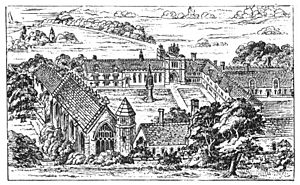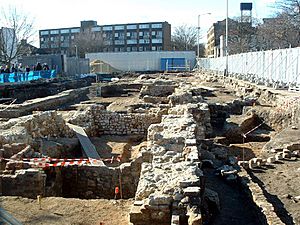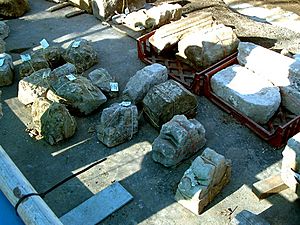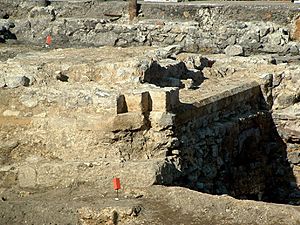Bermondsey Abbey facts for kids
Bermondsey Abbey was an important Benedictine monastery in England. It's best known for being founded in the 11th century. However, there was an even older monastery on the same spot, mentioned as early as the 700s. Today, the abbey's former location is Bermondsey Square, where Bermondsey Market is, in southeast London, England.
Contents
The Abbey's Beginnings & Growth
A monastery existed in Bermondsey before 715 AD. It was like a branch of a bigger monastery called Peterborough. A letter from Pope Constantine (708-715) mentions this early monastery. It likely continued until the Vikings invaded in the 800s.
Nothing more is heard about a church in Bermondsey until 1082. That's when a man named Alwinus Child started a new monastery there. He had permission from the king. This new monastery was probably built on the same holy site as the older one.
A New Church for St Saviour
Alwinus Child's new monastery was dedicated to St Saviour. It was likely the "new and handsome church" mentioned in the Domesday Book in 1086. The Domesday Book was a huge survey of England ordered by William the Conqueror. It showed that King William owned the land in Bermondsey.
King William Rufus (William the Conqueror's son) also supported the abbey. He gave the royal estate at Bermondsey to the monks around 1089 or 1090. Other kings, like Henry I, also gave gifts to the monastery.
Monks Arrive from France
In 1089, four monks arrived from a French monastery called St Mary's of La Charité-sur-Loire. They were invited by Archbishop Lanfranc of Canterbury. These monks made Bermondsey a Cluniac priory. This meant it followed the rules of the Cluny Abbey in France. Peter became the first leader, or prior.
Developing the Land
The monks worked hard to develop the marshy land around the abbey. They grew crops and built banks along the river. They also dug dykes (ditches) to drain the land. They turned a nearby tidal creek into the priory's dock, calling it St Saviour's Dock. This dock was a safe place for important church leaders and goods to arrive. It helped avoid the busy London Bridge.
Becoming an Independent Abbey
Bermondsey remained a Cluniac priory until the late 1300s. In 1380, the first English prior, Richard Dunton, paid a large fee. This made the monastery "naturalised," meaning it was protected from actions against foreign properties during wartime. This step helped it become independent from the French monasteries of La Charité and Cluny. It finally became an independent abbey in 1390.
Bermondsey itself was mostly just a main street (now Bermondsey Street). It led from the River Thames up to the abbey. Other important religious groups, like the Knights Templar, also owned land nearby. In 1353, King Edward III even built a manor house close to the Thames in Bermondsey.
Royal Connections at Bermondsey
Bermondsey Priory had some important royal visitors.
Royal Births and Residences
At Christmas in 1154, the new king, Henry II, and his Queen, Eleanor of Aquitaine, held court at Bermondsey Priory. Just a few weeks later, on February 28, 1155, their second child, Prince Henry, was born there!
Later, Elizabeth Woodville, the wife of Edward IV, came to live at the Abbey in 1487. She was the mother of Elizabeth of York, who married Henry VII. Elizabeth Woodville died at the abbey in 1492.
The Legend of King John's Palace
Because of these royal visits, a story began that King John had built a palace at Bermondsey. An old writer named John Aubrey believed this story. However, later historians couldn't find any proof. It was likely a mix-up with another royal house closer to the Thames, but still on land owned by the Abbey.
Important Burials at the Abbey
Several notable people were buried at Bermondsey Abbey, including:
- Mary of Scotland, Countess of Boulogne
- Ann Echingham, widow of John Tuchet, 6th Baron Audley
- Matthew Baker (governor)
- William, Count of Mortain
Land and Wealth of the Abbey
Bermondsey Abbey quickly became very wealthy. It owned a lot of land and had many rights.
In 1103 and 1104, King Henry I gave the abbey his land in Southwark. This land stretched from Borough High Street to Lambeth and Walworth. It became known as the King's Manor, Southwark. In 1122, the abbey was also given the church of St George the Martyr. A road called Long Lane connected the Abbey to this church.
By 1291, the abbey's land and properties were worth almost £229. Its spiritual rights (like choosing priests for churches) were worth over £50. By 1535, the abbey's total yearly value was over £474.
The abbey's land was spread out across many counties, including Surrey, Leicestershire, Hertfordshire, Buckinghamshire, Gloucestershire, Somerset, and Kent.
- The manor of Charlton (in Kent) was given to the abbey in 1093. In 1268, Bermondsey was allowed to hold a market there every Monday and a three-day fair each year.
- Land in Dulwich was given by Henry I in 1127.
The Abbey's End: Dissolution
During the Dissolution of the Monasteries under Henry VIII, the king forced the last abbot to give up the abbey. Henry VIII then gave the property to Sir Robert Southwell.
Southwell later sold the buildings to Sir Thomas Pope, who founded Trinity College, Oxford. Pope broke up the abbey. He built a new house using some of the old abbey buildings, but he tore down others. Pope then sold it back to Southwell, who sold it again to a London goldsmith.
Sir Thomas Pope died in 1558. The house later belonged to Thomas Radclyffe, 3rd Earl of Sussex. He was an important diplomat and courtier to Queen Elizabeth I. The Queen even visited him there in 1570. During Sussex's time, some abbey buildings were used as a hospital.
What Remains Today
Sadly, neither the abbey nor the later house still stand. By 1822, people reported that only "a solitary fragment or two of stone wall" remained. Some houses on nearby Grange Walk still have parts of the abbey's walls. For example, numbers 5, 6, and 7 include parts of the old stone gatehouse. You can even see the remains of the abbey church's south-western tower under a glass floor in a restaurant on Bermondsey Square!
In 1904, during construction on Abbey Street, workers found two stone coffins with human remains. They also found parts of the abbey's foundations. In 1932, the original stone that marked the abbey's consecration (blessing) was found at a petrol station.
Archaeological Discoveries
The area around Bermondsey Square has been rebuilt many times. Archaeologists have done lots of digs there, especially in 2005–2006. These digs have given us a chance to learn more about the abbey's history. More excavations have also happened along Tower Bridge Road.
Images for kids













